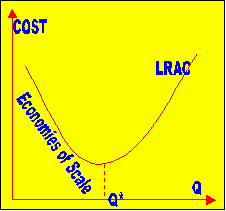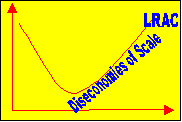 Definition: Definition:
Economies of scale refer to the characteristics of long run
production that causes the LRAC decrease, as plant size is Increase.
Economies of scale refers to the benefits enjoyed by firms (Industry) when long
run production that causes LRAC to decrease as plant size
is increased or extended.
TYPE OF ECONOMIES OF
SCALE
There are two types of Economies of scale
 | i.Internal Economies of scale |
 | ii. External
Economies of scale.
|
i. INTERNAL
ECONOMIES OF SCALE
Definition:
Internal Economies of scale refers to those advantages enjoyed by a firm
operating in a large scale production a rising out of the existing conditions
within the firm,eg big firms
capable of employing specialists such as accountant marketing manager
etc.
 | FACTORS
INFLUENCING INTERNAL ECONOMIES OF SCALE
i.
Technological economies of scale:
This refers to advantage which the firm or producer gets when it uses large
scale equipments and better machines eg
computer etc.
ii. Financial Economies of
scale .
In Large scale production,producer can easly raise finance
from banks,than small scale producer Large scale production lending is regarded
by bank as credit wealth .Therefore Large scale production enables the firms
rescue loans from bank s and from other financial institutions.
iii. Management Economies
When production is undertaken on large scale
,export may be employed and high degree of division of labour and specialization
will help to increase the efficiency of production.
The firm enables to employ manager ,production manager, personal manager etc
this increase efficiency.
iv. Welfare Economies:
A large firm has the capacity and means to welfare
facilities to its workers. This helps to increase their workers morale and
efficiency such as welfare facilities include :
- Recreational facilities
- Hospital facilities eg. schools
- |
 | FACTORS INFLUENCING
EXTERNAL ECONOMIES OF SCALE
i.
Economies
of concentration
These are advantages shared by number of firms or industries which
are built in the same locality.
ii. Economies
of Information
These are advantages, which are shared by
the firms on research findings advertisements etc in order to create market
awaness.
iii. Economies of Integration
Economies of integration refer to advantages which
one share by firms which are producing selected products. |
TYPES
OF INTEGRATION
i. Horizontal
integration
- Amalgamation” ( margin ) of two or more firms at small stage of production.
Eg. Breweries industries merge or a group of commercial Banks margin.
ii. Vertical Integration
- The two or more firms merge at different
stages of production but in the same related industries come together.
Eg. a manufacturing or a processing firm linking with a raw material , supplying
firms or sinking up spinning. Weaving and differing.
iii.
Conglomerate Integration
Two or more firms producing commodities
that are not related come together.
This is where firms producing related commodities
but not completing with one another come together.
ADVANTAGES
OF INTEGRATION OF FIRMS
- * It enables the firms to enjoy economies of scale.
Reduce cost of production.
-
* It creates security.
Assured of the supply of raw materials.
- * Enables the firms
to enjoy market economies.
- * Reduces competition among the firms.
DIS
–ADVANTAGES OF INTEGRATION OF FIRMS.
- Reduction of
competition leads to monopoly market.
- It may lead to unemployment
as labour for a may be reduce.
- Errors may lead to huge
losses e.g. vertical integration.
- Loss of independence,
powers are surrendered to the big major consultations are made at all levels.
DISECONOMIES OF
SCALE
 Definition:
Diseconomies of scale refers to disadvantages faced
by a firm as it expands its scale of production .The diseconomies of scale in
turn limit the expansion of firms. Definition:
Diseconomies of scale refers to disadvantages faced
by a firm as it expands its scale of production .The diseconomies of scale in
turn limit the expansion of firms.
- Diseconomies of scale refers to the situation where the firms or an industry
are characterized by falling in output a longrun average cost curve rises.
|